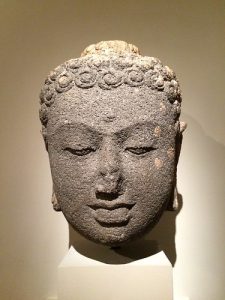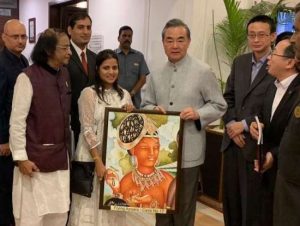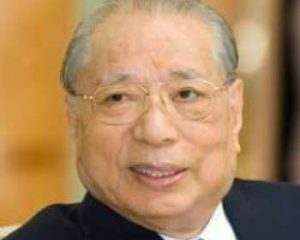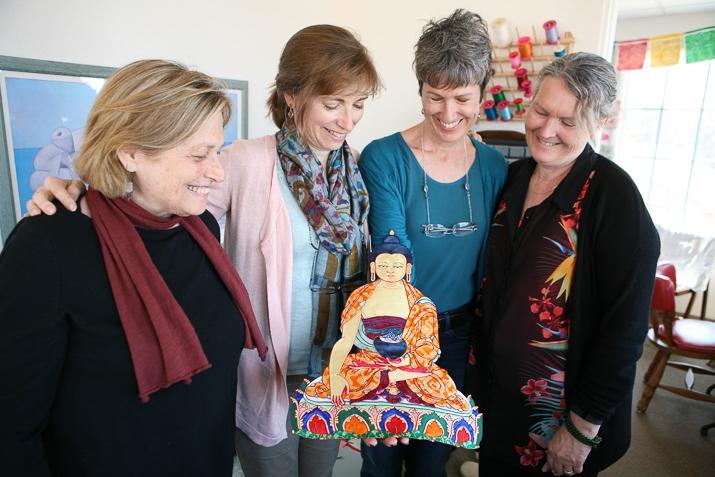
When I began teaching Western women the sacred art of Tibetan appliqué in 2008, I thought I was merely teaching needlework, but I had underestimated the power of the Buddhist tradition and transmission. It was my students that set me straight; through them, I discovered the transformative power of this sacred artwork.
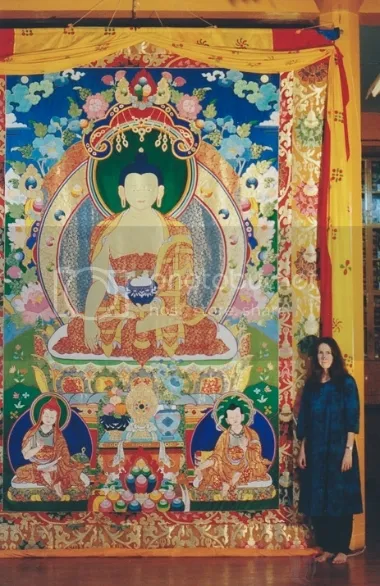
this large appliqué thangka while apprenticing to T. G.
Dorjee Wangdu in Dharamsala in the 1990s
I lived in northern India from 1992 to 2001, where I learned to make silk thangkas under an apprenticeship to Tibetan master craftsmen. A thangka is a rollable wall hanging or scroll depicting a sacred image or spiritual teacher. Most thangkas are painted on canvas and framed in brocade, but I studied a rarer type of thangka in which the images are formed from hundreds of pieces of silk, outlined in hand-wrapped horsehair, and assembled in an intricate patchwork. I first encountered the colors and textures of Tibetan appliqué art in 1992 when I was working as an economic development volunteer for Tibetan refugees. I was mesmerized by the tactile vibrancy of the fabrics and the jigsaw-like arrangemet of elements that pulled pieces into a whole. It brought the imagery of the Buddhist philosophy that I was studying together with a type of handwork and aesthetic that I loved. I immediately began searching for a teacher.
Six days a week for four years, I sat alongside young Tibetans in a sewing workshop just outside the Tsuglagkhang, the Dalai Lama’s temple in McLeod Ganj, Dharamsala. The environment was infused with Dharma, and the sounds of teaching and practice drifted from every window and echoed in every courtyard. Each morning I attended classes in Buddhist philosophy with Tibetan scholars (geshes) before trudging up the steep hill to the workshop, where I stitched thangkas in the afternoon.
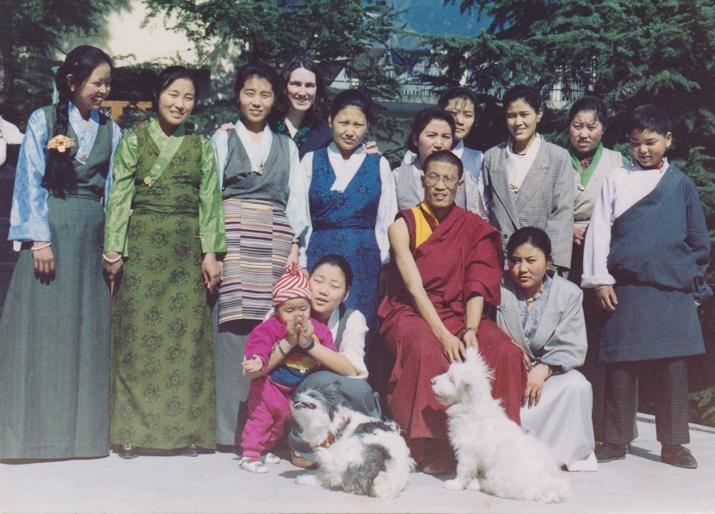
I absorbed the Dharma this community breathed until it emanated through my fingers into the thangkas I stitched. Nevertheless I was far from being a Dharma teacher, and was an inconsistent meditator. After leaving India and taking up teaching, I told prospective students that I would teach them the stitching techniques required for thangka creation, but not the spiritual practice or philosophy associated with the art, and very little iconography. I would tell them not to expect spiritual illumination from me—they must seek that elsewhere. Yet, little did I know that each line and stitch of this artwork carries the light of the Buddhas and of generations of artists and practitioners. One can’t escape the deeper lessons that have been woven into the fabric of this lineage.
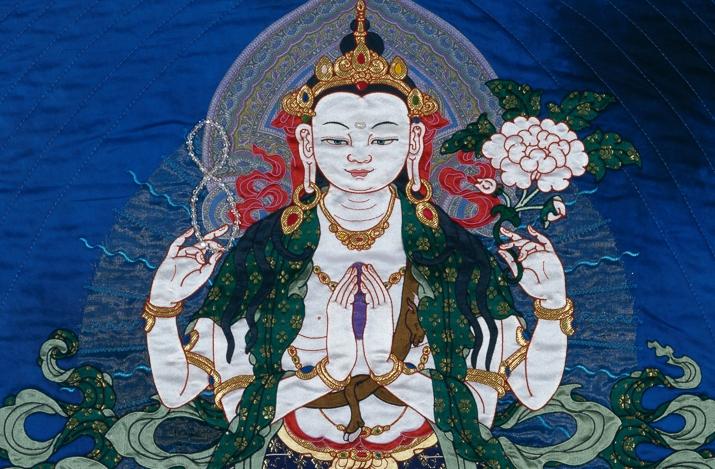
I was living in Italy, married, and making thangkas on commission, when one day in early 2008 I was contacted by an American woman in France called Louise. A practicing Buddhist and a trained costume designer, she had returned to France after many years of following her husband’s career from country to country while raising their young children, and was now seeking an occupation, something meaningful to do with her energy and time. When she first saw the silk thangkas on my website, it struck her as a natural coupling of her creative background and her spiritual practice—the same connection I had felt 16 years earlier when I first entered a Tibetan appliqué studio in India—and she felt compelled to learn the art. My association with Louise led me to draw up a course of instruction in the techniques of Tibetan appliqué and eventually sparked the creation of the Stitching Buddhas Virtual Apprentice Program,* a distance-learning course through which my students can learn the techniques of Tibetan appliqué from written instruction, videos, Skype calls, a private online forum, and an annual retreat.
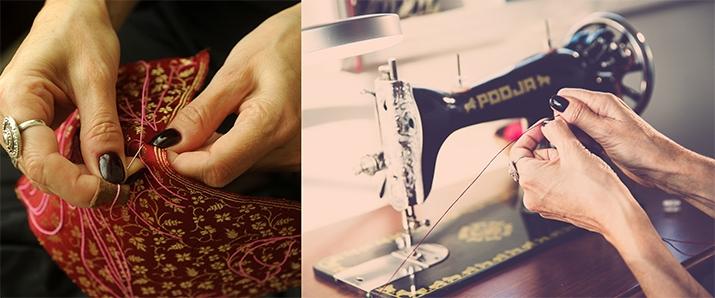
Working with a needle and thread reawakens our tactile intelligence. Our eyes and ears are not the only receptors for learning; the rational mind is not our only mode of understanding; and the voice is surely not our only instrument for communicating. Although in the 21st century our range of manual engagement has largely been reduced to tapping plastic keys and swiping touch-screens, we can also perceive, learn, and communicate through our fingers. People who knit or quilt or work on a potter’s wheel have experienced the mindful quality that can arise from slow, deliberate movement and tactile sensation. Creating something by hand slows down the busyness of life—if only momentarily.
Beyond this, the thread becomes a metaphor for life. You see how things become tangled when you don’t pay attention. You see where perfectionism trips you up, where you are afraid to move forward, and how, sometimes, the more effort you exert, the worse things become. Sometimes gentleness and a relaxed approach are needed. These patterns become evident in the stitching, and such awareness filters into other areas of our life.
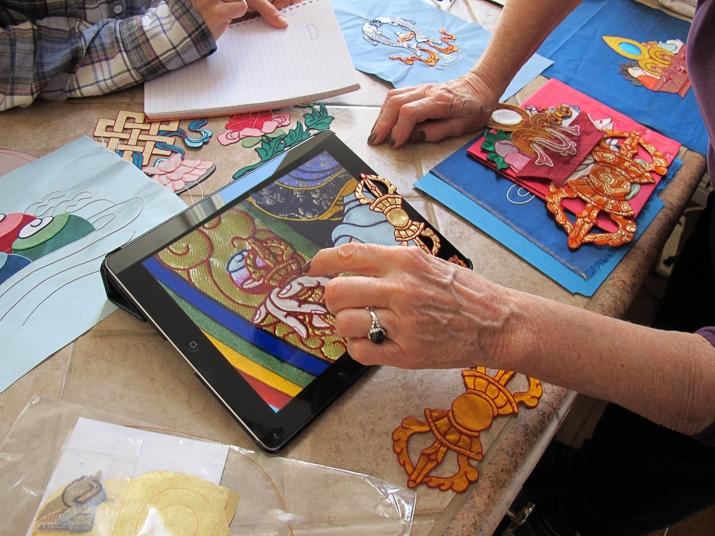
The Tibetan appliqué tradition flows from an ancient spiritual lineage of artists, teachers, and practitioners who have created and used the images as part of their Buddhist practice. When we stitch, we receive their transmission through our fingers. People often ask if I meditate while I stitch. I say that stitching IS meditation. The Tibetan word for meditation—gom—literally means “to familiarize oneself.” Through meditation, we familiarize ourselves with desirable mind states—expansive, loving, generous, imperturbable mind states—in an effort to make them habitual. When we stitch a thangka or even a lotus flower, we are in the presence of enlightenment. We familiarize ourselves with enlightened beings and therefore with the highest qualities of our own nature. The images in our hands symbolize the clearest, highest, best parts of us and of humanity. Stitch by stitch, we allow these qualities to fill us.
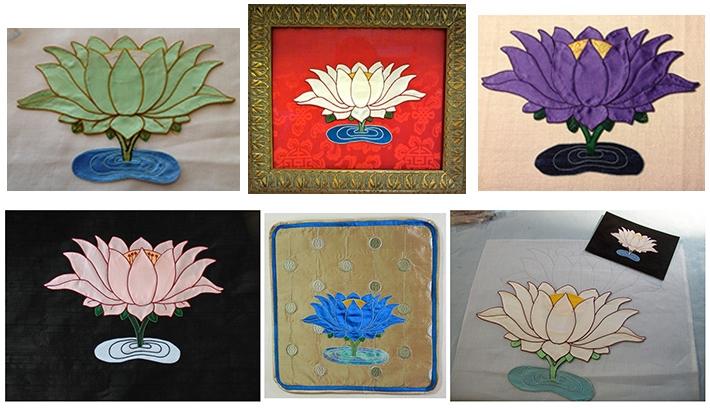
Most of my students, whom I call the “Stitching Buddhas,” are women in their 50s and 60s with a strong interest in Buddhism. They are well educated, many have worked in healing professions such as nursing, medicine, social work, and psychotherapy, and many are mothers of grown children. They come to the practice with an awareness of limited time. Some face diminishing eyesight or challenges to their manual dexterity. Some have no sewing experience at all. And while they’re not preparing for a career in thangka-making, they are seeking to live their lives meaningfully and happily, and to leave something beautiful in their wake.
Buddhism encourages us to recognize our good fortune and to use this precious human life well. Human rebirth is rare and hard to come by. With gratitude in her heart, each Stitching Buddha stitches her own response to the sumptuous question posed by the American poet Mary Oliver: “Tell me, what is it you plan to do with your one wild and precious life?”

Leslie Rinchen-Wongmo is a member of the Dakini as Art collective. She is a textile artist, teacher, and caretaker of the sacred Tibetan tradition of silk appliqué thangkas. Trained by two of the finest living masters of this rare art form, she stitches pieces of silk into fabric mosaics that bring the transformative figures of Buddhist meditation to life. Encouraged by His Holiness the Dalai Lama to make this art relevant across religions and cultures, Leslie created the Stitching Buddhas Virtual Apprentice Program to help women around the world integrate their spiritual and creative paths. To learn more about Leslie, her work, and Dakini As Art, please visit Dakini as Art.
* Stitching Buddhas Virtual Apprentice Program
See more
Leslie Rinchen-Wongmo, Threads of Awakening (Homepage)
Stitching as Meditation in the Pieced-Silk Thangkas of Leslie Rinchen-Wongmo (Buddhistdoor Global)




